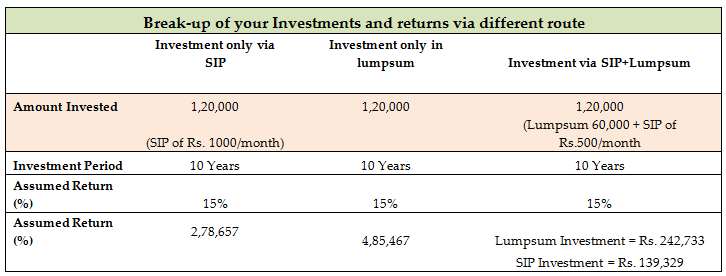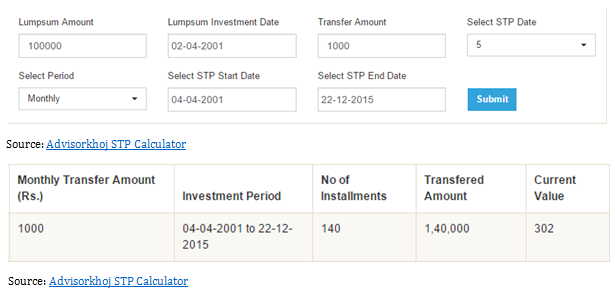Lump sum Versus Systematic Investing: Which one is better

There are some debates that may feel ancient and relevant all at the same time. The debate of Systematic Investing Versus Lump sum is one of those. AMCs came, new funds were introduced and ages have passed since the first Mutual Fund was introduced. However, investors curiosity to know the answer remains the same. There are equally good arguments on both the sides of Systematic Investment plan (SIP) and lump sum and in some ways one is better than the other and not. It is like a toss. Sometimes you need a tails to win and sometimes a heads is good enough. However, on any given day you cannot say which one is better. The age old argument can be summed up in this one line: to each his own.
Investment in Mutual Funds could get confusing rather fast. There exists both equally lucrative means of investment. What is the fundamental difference between both the means? The difference lies in cash flows. In case of lump sum the investor has the surplus and invests in one go. In case of a SIP the surplus is created at regular intervals. It is usually assumed that SIPs generate better returns than lump sum and this word of mouth has gotten around and this is considered to be a general rule. Is it also the truth? Let us first look in to how lump sum and SIP can be used by investors.
Is Systematic Investment Plan Suitable for You
Systematic Investment Plan (SIP) has been designed to allow investors the ease of investment where investors do not have to part with lump sums to make their investments work. Investments through SIP can be done in an automated manner without the interference of the investor in the process.
Young Investors: It is best suited for young investors, who may have sums as small as र 500. It allows them to get their first taste of investment.
Regular Income: it is also suited for individuals who have a regular flow of income and surplus. SIP allows investors the flexibility to continue investments even if they have missed a month. They can add additional investments to an ongoing SIP in case of excess surplus.
Know the Exact Amount: If an investor knows the exact amount they have to achieve for the future goal then SIP investments can aid in that. They can calculate that investing र 10,000 for the course of next 20 to 30 years on an average return of 15 – 18% will be enough to reach their goals and might have surplus at the end of it. In case they feel that the investment is lagging behind they can add lump sum at the end but the continuous monthly payment allows them to reach a hefty corpus.
You may try this calculator to know the future value of your SIP
Is lump Sum Investment Suitable for You
Lump sum is that mode of investment which allows seasoned investors or individuals with large amounts of surplus to invest in one go. This ensures that the money does not lie ideally in a bank account losing out on the compounding value.
Seasoned investors: They may have generated large sums of returns which they wish to reinvest in one go. With age their income may have also progressed allowing them to have larger amounts of surplus. Seasoned investors also understand the market a little better than the newcomers. Hence, they can invest the lump sum when the market is a low gaining more units in a fund.
Uncertain income: Individuals with uncertain but substantial cash flow may prefer to invest via lump sum rather than missing out on SIP payments. This allows them to stay invested despite differing cash flows. This investment can aid you during lean times when you could withdraw from the lump sum using the Systematic Withdrawal Plan. This does not require you to redeem the entire corpus rather a stipulated amount at a time and the rest of the corpus keep earning returns.
SIP Vs Lump Sum: An Empirical Analysis
SIP or Lump sum: We all have been looking for definite answers. In varying situation, one or the other looks ideal. This leads to a lot of debate and discussion. However, the point is to ensure that investments are made by investors. Let us now look at an example -

The above table explores three investment scenarios: SIP, Lump sum and a mix of both. Simplistically speaking, it is understood that a Lump sum invested over a long period of time will have larger investment value than that of an SIP. This is because of the effect of power of compounding over a period of 10 years. Whereas, the SIP instalments are staggered over a period of 10 years and therefore the entire investment did not get the sufficient time to benefit from power of compounding. In case of the third option, Investment via SIP and lumpsum, though the lumpsum is benefited by power of compounding, the compounding benefit in SIP part is benefited partly due to the staggered instalments.
Systematic Investment Planning: The Psychological Veil
Investors fear investment in lump sum because if they fail to time the market they will invest when the NAV is higher. It is commonly thought that if you invest in a high market, the number of units allotted is lesser. Hence, the return is lower as well as the average cost is higher. In case of SIP, investors have the mindset that they can time the investments and invest always at a lower average cost, thus buying more number of units. This lowers the average cost and increases the returns. This is known as the psychological veil of SIPs where even in Mutual Funds investors try to time their investments. While this understanding is slightly skewed SIP does solve a few problems for investors which could otherwise become stumbling blocks.
Most of the SIP investments being automated, you automatically buy more units when price is low and lesser units when prices are high. On an average, you have higher units purchased at a lower price. They smooth out the slight ups and downs due to the Rupee cost averaging of SIPs. The second problem it solves is investors redeem when markets are falling and invest when the markets rise, while the opposite should ideally be taking place. SIP does not let this mentality prevail. The investments in SIPs continue because it is a monthly payment irrespective of the markets. Investors do not time markets because they are aware of the averaging that is carried out. Hence, psychologically it relieves the investor of having to worry about the investments.
Systematic Transfer Planning of Mutual Funds
As an investor you could obviously want to invest in SIPs while having a lump sum to hold on. What do you do in that case? Leaving the amount in a bank savings account is foolhardy as the returns generated are meagre. You could try Systematic Transfer Planning - in this plan, you transfer a fixed amount from a liquid or cash fund to another fund, say an equity fund or balanced fund or MIPs. If you have invested a lump sum in Liquid Funds and are transferring the amount in the form of an STP, you get double benefit.
- The benefit of staying invested for the lump sum and earning returns higher than that of bank savings account
- Earning return on the invested STP amount the way you would have got in case of SIPs
In this case, an investor will notice that the lump sum that he had initially planned on investing has increased substantially. The total amount invested in STP is much higher than the initial investment.
In the above image it is seen that the lump sum amount invested was र 1,00,000 lac and the transfer amount per month is र 1000 for 14 years. The second image shows the STP fund where in 140 instalments of Rs 1,000 each र 1,40,000 was invested. Hence, you got र 40,000 more than what you had initially set out for investing. Your lump sum corpus received a 40% boost because of the investment in liquid funds.
You may like to try this Systematic Transfer Plan Calculator before you invest.
Conclusion
A lot has been written on this debate and one can say without any speck of doubt that a lot will be written in the times to come. However, at the end the choice has to be the investor’s which needs to be taken on the basis of their income, their cash flow, their financial goals (You may try this to plan your future goals https://www.advisorkhoj.com/tools-and-calculators/composite-financial-goal-planner-calculator ) and how they wish to achieve that. Both the routes of investment remain open to an investor and they can always choose middle path to get the both worlds. Just because these are two means of investment does not mean they are definitive modes. One can go for Systematic Investment plan (SIP) if one has a regular income and keep boosting their investments by investing through lumpsum whenever they have surplus amount to investment. For investors who have large surplus and do not want to take risk by investing it in one go, Systematic Transfer Plan (STP) can be the best way of investing as you enjoy the best of the both worlds. While the debate rages on, you make an informed choice and leave the investment for a long term by consulting with your mutual fund advisors or your financial planner.
RECOMMENDED READS
LATEST ARTICLES
- Why you need to have hybrid mutual funds in your portfolio: Different types of funds Part 2
- Why you need to have hybrid mutual funds in your portfolio: Misconceptions Part 1
- Which is the best time to invest in mutual funds
- Economic slowdown: Is it real and what should you do
- Importance of liquidity in investing: Mutual funds are ideal solutions
An Investor Education Initiative by ICICI Prudential Mutual Fund to help you make informed investment decisions.
Quick Links
Follow ICICI Pru MF
More About ICICI Pru MF
POST A QUERY





